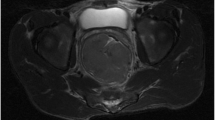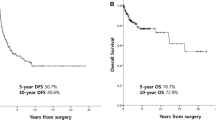Abstract
PURPOSE: The aim of this study is to present the prognosis and possible associated prognostic factors after curative resection of rectal leiomyosarcoma. METHODS: From 1979 to 1996 our hospital saw 40 patients with rectal leiomyosarcoma, including 19 females, who did not have metastasis initially and received curative resection and regular postoperative follow-up. RESULTS: The mean age of the 40 patients was 58.7 years. Anal bleeding and perianal pain were the two most common symptoms at initial diagnosis. Twenty-nine patients received a radical surgical resection, such as abdominoperineal resection or low anterior resection; the other 11 patients received a wide local excision, such as transrectal excision or Kraske's operation. Sixteen tumors were classified as high-grade leiomyosarcoma, and 23 as low grade. Nineteen patients (48 percent) developed recurrence or metastasis postoperatively (median follow-up, 35 months). The overall and disease-free (1-year, 3-year, and 5-year) survival rates were 97, 90, and 75 percent and 90, 59, and 46 percent, respectively. In univariate analysis, younger group (<50 years, n=9,P=0.033) and high-grade leiomyosarcoma (P=0.043) showed poorer prognosis in the disease-free survival curve. In the multivariate Cox model, gender, tumor size, tumor location, and operation type did not significantly affect disease-free survival, whereas histologic grade (P=0.037) and age divided by a level of 50 years (P=0.009) were shown to be independent factors. There was a strong trend toward higher local recurrence rate for the wide local excision group than for the radical resection group (55vs. 24 percent,P=0.067) despite the wide local excision group being composed of smaller tumors (5.1vs. 7.5 cm,P=0.069). There was no difference in the incidence of distant metastasis between the two groups with different operation types. The metastasis rates of the wide local excision and radical resection groups were 27 and 38 percent, respectively. CONCLUSION: A younger age (<50 years) and a high histologic grade of tumor were the two most significant poor prognostic factors for rectal leiomyosarcoma. Radical resection may be superior to wide local excision in the prevention of local recurrence but not distant metastasis.
Similar content being viewed by others
References
Diamante M, Bacon HE. Leiomyosarcoma of the rectum: report of a case. Dis Colon Rectum 1967;10:347–51.
Somervell JL, Mayer PF. Leiomyosarcoma of the rectum. Br J Surg 1971;58:144–6.
Khalifa AA, Bong WL, Rao VK, Williams MJ. Leiomyosarcoma of the rectum: report of a case and review of the literature. Dis Colon Rectum 1986;29:427–32.
Randleman CD Jr, Wolff BG, Dozois RR, Spencer RJ, Weiland LH, Ilstrup DM. Leiomyosarcoma of the rectum and anus: a series of 22 cases. Int J Colorectal Dis 1989;4:91–6.
Vandoni RE, Givel JC, Essinger AR. Rectal leiomyosarcoma: acute presentation after local injury. Eur J Surg 1992;158:383–6.
Labow SB, Hoexter B. Leiomyosarcoma of the rectum: radicalvs. conservative therapy and report of three cases. Dis Colon Rectum 1977;20:603–5.
Exner A. Ueber nichtmelanotische Sarkome des Mastdarmes. Med Klin Berlin 1908;4:858–61.
Neuman Z. Leiomyosarcoma of the rectum developing from benign leiomyoma. Ann Surg 1952;135:426–30.
Hishida Y, Ishida M. Smooth-muscle tumors of the rectum in Japanese. Dis Colon Rectum 1974;17:226–34.
Evans HL. Smooth muscle tumors of the gastrointestinal tract: a study of 56 cases followed for a minimum of 10 years. Cancer 1985;56:2242–50.
Akawn OE, Dozios RR, Weiland LH. Leiomyosarcoma of the small and large bowel. Cancer 1978;42:1375–84.
Cox DR. Regression models and life tables. J R Stat Soc 1972;34:187–220.
Kusminsky RE, Bailey W. Leiomyomas of the rectum and anal canal: report of six cases and review of the literature. Dis Colon Rectum 1977;20:580–99.
Hanahan D, Folkman J. Patterns and emerging mechanisms of the angiogenic switch during tumorigenesis. Cell 1996;86:353–64.
O'Reilly MS, Holmgren L, Shing Y,et al. Angiostatin: a novel angiogenesis inhibitor that mediates the suppression of metastasis by a Lewis lung carcinoma. Cell 1994;79:315–28.
O'Reilly MS, Rosenthal R, Sage H,et al. The suppression of tumor metastasis by a primary tumor. Surg Forum 1993;44:474–6.
Author information
Authors and Affiliations
About this article
Cite this article
Yeh, CY., Chen, HH., Tang, R. et al. Surgical outcome after curative resection of rectal leiomyosarcoma. Dis Colon Rectum 43, 1517–1521 (2000). https://doi.org/10.1007/BF02236730
Issue Date:
DOI: https://doi.org/10.1007/BF02236730




